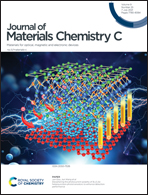Large Stokes shifted quaternary copper cadmium sulfide selenide quantum dot waveguides†
Abstract
Stokes shift engineering of quantum dots is an attractive approach to enhance luminescence efficiency by reducing reabsorption losses. We report for the first time a route to the colloidal synthesis of new quaternary alloyed I–II–VI2 copper cadmium sulfide selenide quantum dots exhibiting bright and stable photoluminescence with an absolute photoluminescence quantum yield of 62%. The alloyed quantum dots exhibit a record Stokes shift of 670 meV, which can be further tuned by composition variation during annealing. This large Stokes shift leads to minimum reabsorption, a feature beneficial to obtain bright photoluminescence. We fabricate optical waveguide slabs by impregnating quantum dots in polydimethylsiloxane to transmit the photoluminescence of the quantum dots without significant deviation of efficiency. The waveguide slabs show an average visible transmittance of 70% and flexibility over a wide range of bending angles. Our approach to obtain an unprecedented combination of a large Stokes shift and a high photoluminescence quantum yield illustrates the potential of quaternary quantum dots for meeting the requirements of reliable, sustainable and competitive modulated light guiding systems.



 Please wait while we load your content...
Please wait while we load your content...